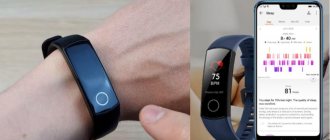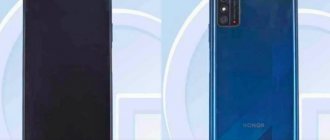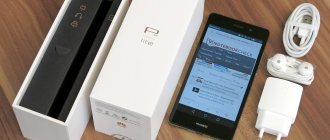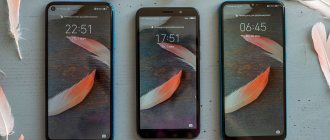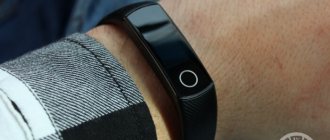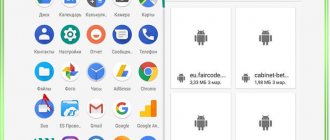I wrote about Huawei’s tactics when creating flagship Honor series smartphones in a preliminary review straight from the event - the company takes its top-end device, presented about six months before the key announcement of the sub-brand, packages it in a new wrapper, slightly (very slightly) changes the characteristics and sells it for a third cheaper. Voila - a ready-made hit! It worked with last year's Honor 8, which grew out of the Huawei P9, and it also works with the Honor 9 - the actual result of a restyling of the Huawei P10.
At the same time, Honor 9 inherits its predecessor in style - the Chinese did not fundamentally change the design, so we are dealing with another shiny gadget that shimmers in the light. Except that a key with a fingerprint scanner appeared on the front panel, the dimensions changed slightly, and the back cover received rounded edges - now, unwittingly, designers will run into comparisons with Xiaomi Mi6. Well, this is the most direct competitor for the new Honor; a head-on collision with it cannot be avoided.
If we ignore the design, then perhaps the only difference from the Huawei P10 that catches the eye is the disappearance of references to Leica as a partner in the development of the camera. At the same time, the camera characteristics themselves remained unchanged: a dual module with an RGB sensor of 13 megapixels and a monochrome sensor of 20. Let's see how well it performs without the (visible) influence of Leica. Well, let's check other capabilities of the smartphone, of course.
Specifications
| Honor 9 | Huawei P10 | Honor 8 | Xiaomi Mi6 | OnePlus3 | |
| Display | 5.15 inches, IPS, 1920 × 1080 pixels, 428 ppi, capacitive multi-touch | 5.1 inches, IPS, 1920 × 1080 pixels, 432 ppi, capacitive multi-touch | 5.2 inches, IPS, 1920 × 1080 pixels, 424 ppi, capacitive multi-touch | 5.15 inches, IPS, 1920 × 1080 pixels, 428 ppi, capacitive multi-touch | 5.5 inches, AMOLED, 1920 × 1080 pixels, 401 ppi, capacitive multi-touch |
| Protective glass | No information | No information | No information | Yes, manufacturer unknown | Corning Gorilla Glass 4 |
| CPU | HiSilicon Kirin 960 (four ARM Cortex-A73 cores, 2.4 GHz + four ARM Cortex-A53 cores, 1.8 GHz) | HiSilicon Kirin 960 (four ARM Cortex-A73 cores, 2.4 GHz + four ARM Cortex-A53 cores, 1.8 GHz) | HiSilicon Kirin 950 (four ARM Cortex-A72 cores, 2.3 GHz; four ARM Cortex-A53 cores, 1.8 GHz) | Qualcomm Snapdragon 835 MSM8996 (quad Kryo cores, 2.45 GHz + quad Kryo cores, 1.9 GHz) | Qualcomm Snapdragon 820 MSM8996 (dual Kryo cores, 2.15 GHz + dual Kryo cores, 1.36 GHz) |
| Graphics controller | ARM Mali-G71 MP8, 850 MHz | ARM Mali-G71 MP8, 850 MHz | Mali-T880 MP4, 900 MHz | Adreno 540, 710 MHz | Adreno 530, 624 MHz |
| RAM | 4 GB (6 GB version available) | 4 GB | 4 GB | 6 GB | 6 GB |
| Flash memory | 64 GB (there is a version with 128 GB) | 32/64 GB | 32/64 GB | 64/128 GB | 64 GB |
| Memory card support | Eat | Eat | Eat | No | No |
| Connectors | USB Type-C, 3.5 mm mini-jack | USB Type-C, 3.5 mm mini-jack | USB Type-C, 3.5 mm mini-jack | USB Type-C | USB Type-C, 3.5 mm mini-jack |
| SIM cards | Two nano-SIMs | Two nano-SIMs | One nano-SIM/two nano-SIM | Two nano-SIMs | Two nano-SIMs |
| Cellular connection 2G | GSM 850/900/1800/1900 MHz | GSM 850/900/1800/1900 MHz | GSM 850/900/1800/1900 MHz | GSM 850/900/1800/1900 MHz | GSM 850/900/1800/1900 MHz |
| Cellular 3G | HSDPA 850/900/1900/2100 | HSDPA 800/850/900/1700/1900/2100 | HSDPA 850/900/1700/1900/2100 | HSDPA 850/900/1900/2100 | HSDPA 850/900/1900/2100 MHz |
| Cellular 4G | LTE Cat. 6 (300/50 Mbit/s): bands 1, 3, 5, 7, 8, 20, 38, 40, 41 | LTE Cat. 12 (600/150 Mbps): bands 1, 2, 3, 4, 5, 6, 7, 8, 9, 12, 17, 18, 19, 20, 26, 28, 38, 39, 40, 41 | LTE Cat. 6 (300/50 Mbit/s): bands 1, 3, 7, 8, 20 | LTE Cat. 16 (1000/150 Mbit/s): bands 1, 3, 5, 7, 8, 38, 39, 40, 41 | LTE Cat. 6 (300/50 Mbit/s): bands 1, 2, 3, 4, 5, 7, 8, 9, 17, 18, 19, 20, 28, 29, 38, 39, 40, 41 |
| WiFi | 802.11a/b/g/n/ac | 802.11a/b/g/n/ac | 802.11a/b/g/n/ac | 802.11a/b/g/n/ac | 802.11a/b/g/n/ac |
| Bluetooth | 4.2 | 4.2 | 4.2 | 5.0 | 4.2 |
| NFC | Eat | Eat | Eat | Eat | Eat |
| Navigation | GPS, A-GPS, GLONASS, BeiDou | GPS, A-GPS, GLONASS, BeiDou, Galileo | GPS, A-GPS, GLONASS | GPS, A-GPS, GLONASS, BeiDou | GPS, A-GPS, GLONASS, BeiDou |
| Sensors | Light, proximity, accelerometer/gyroscope, magnetometer (digital compass), IR sensor | Light, proximity, accelerometer/gyroscope, magnetometer (digital compass), IR sensor | Light, proximity, accelerometer/gyroscope, magnetometer (digital compass), IR sensor | Light, proximity, accelerometer/gyroscope, magnetometer (digital compass), barometer, IR sensor | Illumination, proximity, accelerometer/gyroscope, magnetometer (digital compass) |
| Fingerprint's scanner | Eat | Eat | Eat | Eat | Eat |
| Main camera | Dual module, 20 + 12 MP, ƒ/2.2, hybrid autofocus, dual LED flash | Dual module, 20 + 12 MP, ƒ/2.2, hybrid autofocus, optical stabilization, dual LED flash | Dual module, 12 MP, ƒ/2.2, phase detection autofocus, LED flash | Dual module, 12 MP: 27 mm, ƒ/1.8 + 52 mm, ƒ/2.6 (2x zoom); Optical stabilizer operates at wide angles; phase detection autofocus, dual LED flash | 16 MP, ƒ/2.0, phase detection autofocus, optical stabilization, LED flash |
| Front-camera | 8 MP, ƒ/2.4, fixed focus | 8 MP, ƒ/1.9, fixed focus | 8 MP, fixed focus | 8 MP, fixed focus | 8 MP, fixed focus |
| Nutrition | Non-removable battery 12.16 Wh (3200 mAh, 3.8 V) | Non-removable battery 12.16 Wh (3200 mAh, 3.8 V) | Non-removable 11.4 Wh battery (3000 mAh, 3.8 V) | Non-removable 12.73 Wh battery (3350 mAh, 3.8 V) | Non-removable battery: 11.3 Wh (3000 mAh, 3.8 V) |
| Size | 147.3 × 70.9 × 7.45 mm | 145.3 × 69.3 × 6.98 mm | 145.5 × 71 × 7.5 mm | 145.2 × 70.5 × 7.45 mm | 152.7 × 74.7 × 7.4 mm |
| Weight | 155 grams | 145 grams | 153 grams | 168/182 grams (regular/ceramic version) | 158 grams |
| Housing protection | No | No | No | Splash protection | No |
| operating system | Android 7.0 Nougat, own EMUI shell | Android 7.0 Nougat, own EMUI shell | Android 6.0 Marshmallow, own EMUI shell | Android 7.1.1 Nougat, own MIUI shell | Android 6.0 Marshmallow, OxygenOS shell |
| Current price | 26,990 rubles | 35,990 rubles | 22,000-25,000 rubles | 29,990 rubles | 26,000 rubles |
| Honor 9 – information about the filling according to the CPU-Z application | ||||
Specifications
- Screen: 5.15 inches, IPS (LTPS) OGS, 1920×1080 428ppi, oleophobic coating, polarizing filter, 2.5D;
- Operating system: EMUI 5.1 (Android 7.0);
- Chipset: Kirin 960;
- CPU: Cortex-A73 (4x 2.36 GHz) + Cortex-A53 (4x 1.84 GHz);
- GPU: ARM Mali-G71 MP8 (850 MHz);
- RAM: 4 GB or 6 GB LPDDR4;
- Built-in memory: 64 GB or 128 GB (eMMC) + microSD up to 256 GB;
- Cameras: dual main: 12 MP + 20 MP (f/2.2, laser autofocus, dual LED flash); front: 8 MP (f/2.4);
- Battery: 3200 mAh, non-removable;
- Dimensions: 147.3 x 70.9 x 7.45 mm;
- Weight: 155 g;
- SIM slots: 2 nano-SIM, slot combined with microSD;
- Communication: FDD-LTE: B1 / B3 / B5 / B7 / B8 / B20; TD-LTE: B38 / B40 / B41, Bluetooth: 4.2, Wi-Fi 802.11b/g/n/ac (Dual-Band), GPS (A-GPS), GLONASS, BDS, IR port, NFC, USB OTG;
- Sensors: light, proximity, accelerometer, gyroscope, Hall sensor, fingerprint, compass, step detector;
- Available colors: blue, gray, black;
- Package contents: charger (9B2A), USB Type-C cable, transparent protective bumper, card eject tool, quick start guide.
Appearance
There are three colors on the Russian market: blue, gray and black. The first one managed to become a signature for the company, is the brightest of those presented, and looks advantageous.
The test turned out to be a gray version of Honor 9. An excellent alternative to the boring white one. The color has not previously been seen in the Huawei product line - new and exclusive to Honor 9!
The appearance of the smartphone is an evolution of last year’s Honor 8. The general concept remains the same, we have a glass sandwich with a metal frame. The dual camera still does not protrude, and the rear surface reflects light beautifully. But the design cannot be called the same; the appearance has been updated in accordance with modern fashion. The back cover has become curved; The fingerprint scanner took the place of the logo on the front panel, respectively, the control keys moved under the screen, no more virtual navigation bars.
The front panel is covered with rounded 2.5D Gorilla Glass 3 glass, which smoothly turns into a polished edge that runs along the entire perimeter. The bezels around the screen, even by today's standards, are thin, but two-tone. The display is additionally framed by a black stripe, which merges into the main frame to match the color of the body at the point where the glass is rounded.
Above the screen there is a front camera, proximity and light sensors, a multi-color LED indicator and a speaker. Moreover, the indicator is located under the protective mesh of the speaker, like last year’s Honor 8 - an original solution, no extra windows.
Below the display is a touch-sensitive home button with a built-in fingerprint sensor. The scanner came from the flagship Huawei P10. It works quickly, at the level or faster than OnePlus 3T, noticeably ahead of Xiaomi Mi6. In everyday use, accuracy is maximum, error is a rare exception. Two touch buttons - backlit dots are located to the left and right of the scanner.
Moreover, in the settings you can select three modes of navigation keys. Two classic - three buttons: back, home, recent applications in different combinations. The third mode was inherited from the flagship Huawei P10 and is focused on gestures.
The back panel, made using photoengraving technology, is the highlight of the smartphone! An element of style that significantly sets the device apart from other glass smartphones. At first glance it looks like an ordinary, slightly mirrored back cover, but as soon as the light hits it, the first impression is a thing of the past! The lid plays very beautifully in the light, you can look at the reflected stripes forever, each time a new combination is literally mesmerizing!
The main dual camera is located in the upper left corner of the rear panel. To the right is a two-tone diode flash and a laser autofocus unit. In the center, below the camera block, there is the inscription honor in a corporate font. And at the very bottom there is service information.
At the bottom: a 3.5 mm mini-jack for connecting headphones, a USB Type-C port, a microphone and a multimedia speaker. Moreover, the microphone is hidden under the same slot as the speaker. Antenna dividers are located along the edges of the lower edge.
On top is an additional microphone for noise reduction and stereo sound recording and an IR transmitter.
On the side faces there is a second pair of antenna dividers. On the left is a combined slot for two nano-SIMs, one of which can be replaced with a microSD memory card. On the right is the volume rocker and the power button; the keys have a slight, clear stroke and are easy to feel.
By today's standards, Honor 9 is a compact smartphone that is easy to use with one hand. It is worth admitting that the body is slippery and tends to slide off any slightly uneven surface! After a short acquaintance, you begin to take this feature into account, even your grip changes.
Like any other glass smartphone, Honor 9 is a branded device that instantly becomes covered with stains, which is typical for all colors presented. One thing that saves is the effective oleophobic coating of the front and rear windows, which makes the body easy to clean. Stains are wiped off even in a pocket due to friction against the fabric.
Display
Honor 9 uses a matrix made using IPS (LTPS) technology with a diagonal of 5.15 inches and FullHD resolution (1920 × 1080 pixels), 428 ppi. As already mentioned, the display is protected by third-generation curved 2.5D Gorilla Glass. The oleophobic coating is of high quality, the finger glides as it should, there are no problems with surface contamination.
The display module is made using OGS technology, that is, without an air gap between the components, which gives excellent viewing angles. At extreme angles the contrast drops slightly, no more distortion. The quality of the matrix is up to par: the brightness is sufficient even in the sun, the color rendition is natural, the backlight is uniform, there are no highlights, the blacks are not bad for an IPS matrix. Auto brightness works correctly, no issues. In general, it’s hard to find fault with the screen; it’s what it should be like in a modern A-brand smartphone.
The touch panel supports 10 simultaneous touches - the device is pleasant to operate, the touch works as expected. Also, for working with gloves, there is a special mode that increases the sensitivity of the panel.
One of the software features is color temperature adjustment. In addition to three presets, fine-tuning by color wheel is available. Additionally, a reading mode is available, which removes harmful blue color from the gamut. In addition to manual activation, automatic scheduled activation is available.
Cameras
Photo capabilities are another advantage of Honor 9; the device takes pictures beyond your budget! The smartphone is equipped with a dual camera, one module is 12 MP, and the second is monochrome 20 MP. The focal length is the same, the aperture is the same - f/2.2. At first glance, it may seem that the camera is identical to the one used in the older Huawei P10, but the mention of Leica has disappeared. Apparently, Honor 9 uses simpler optics, which also confirms the lack of optical stabilization. But the laser autofocus and dual-tone flash remain in place!
During the day, the camera works at its best: the pictures are clear and detailed. Autofocus works at lightning speed, no errors were noticed. Additionally, you can activate HDR, which makes shooting just as fast. In general, taking photographs is a pleasure, the automation works correctly: you point and get the finished shot!
Those who don't trust automation will like the pro mode, which allows you to control exposure manually. The following parameters are available: metering mode, ISO sensitivity (from 50 to 3200), shutter speed (from 1/4000 s to 30 s), exposure compensation, manual focus and white balance in Kelvin (from 2800K to 7000K). In the settings you can also activate shooting in RAW for subsequent processing.
The use of two main camera modules significantly expands its capabilities. One of the features is a twofold increase without loss of quality. Unlike models that use two modules with different focal lengths, in Huawei smartphones the effect is achieved through a second monochrome module with a higher resolution, which receives significantly more information. As a result, the magnification cannot be called optical; it is based on high resolution and software processing, but there is no dependence on illumination, the magnification works the same, because the light sensitivity of the optics is the same.
The second application of the dual camera is “Wide Aperture Mode”, which simulates aperture changes that are physically impossible on a smartphone. The result is a bokeh effect, that is, a beautifully blurred background.
An important advantage of Huawei’s solution is the ability to adjust the depth of field effect both during shooting and after the fact. In addition, you can apply various effects, for example, making the background black and white.
These are not all modes! The software is replete with features: monochrome photography, live photography, a separate night mode, taking pictures with a luminography effect - I'm afraid that this is not all! Perhaps the most interesting camera, hardly any other manufacturer can offer so many interesting modes that work as stated in the description, and all the pictures were taken without using a tripod! Huawei also took care of convenience, for example, the quick shooting option. When you activate the camera by double pressing the volume down button, the smartphone takes one photo.
At night, optics that are not the most photosensitive, by today's standards, begin to take their toll. Due to the second monochrome module, the result is better than smartphones with similar optics and one “eye”, but loses to competitors with more light-sensitive optics. However, not everything is so bad, the night shots are decent, at least not embarrassing, and besides, the Honor 9 has a powerful two-tone flash in its arsenal!
As for the video, everything is traditional: 4K 30 FPS, 1080P 60 FPS. And in slow motion mode, the smartphone records 1080P 90 FPS and 720 120 FPS. The sound is in stereo and is recorded well. Surprisingly, software stabilization works perfectly, smoothing out steps no worse than optical stabilization!
8 MP front camera with f/2.4 aperture. During the day there is nothing to comment on; the high resolution provides good detail. Software background blur is available, it doesn't work as well as with the two main modules, but there's nothing to complain about. The retouching effect is also in place, the processing is neat.
In the evening, the camera also copes, but detail begins to suffer. But in pitch darkness, illuminating the face with the screen comes to the rescue; it works well, the face is illuminated evenly.
Iron
Huawei is one of the few companies that uses proprietary hardware platforms. Honor 9 was no exception and received a flagship chipset - Kirin 960, which debuted with the Mate 9 phablet at the end of 2016, and is also used in the P10 flagship. The platform includes 4 Cortex-A73 cores with a frequency of up to 2.36 GHz, 4 Cortex-A53 cores with a frequency of up to 1.84 GHz, and an ARM Mali-G71 MP8 graphics accelerator operating at a frequency of 850 MHz. The technological process level is 16 nm. The platform is served by 4 GB LPDDR4 RAM and a 64 GB internal eMMC drive. Honor 9 Premium has more memory - 6 GB of RAM and 128 GB of storage.
Kirin 960 is definitely a flagship platform! All possible tasks are completed with a bang: everyday work, heavy games - it doesn’t matter, there are no performance problems! Against the background of the latest developments from Qualcomm and Samsung, the platform looks confident; in today's realities there is nothing to complain about; there is a reserve for several years to come.
But the Kirin 960 is a heat-loaded platform; the smartphone begins to heat up significantly under load. For example, during the GFXBenchGL test, the temperature remained at 60 degrees, which was felt in the hand. The heat is well distributed throughout the body, the metal frame heats up evenly and begins to work as a radiator. Glass has poorer thermal conductivity and heats up noticeably less, making the phone more comfortable to use. The company's engineers thought about the heat sink! For example, Qualcomm Snapdragon 835 is much more difficult to warm up, Xiaomi Mi6 remains barely warm. Perhaps the phenomenon is due to the fact that the chipset is built using a 16 nm process technology, while competitors use 14 nm or even 10 nm.
Thus, a mid-range smartphone competes with flagships, noticeably ahead of mid-budget platforms from other manufacturers. This is the main advantage of Huawei’s approach, when after a short period of time the top-end chipset becomes the basis of a device with a more affordable price.
Huawei Honor 9 results in AnTutu Benchmark
In the popular AnTuTu benchmark, the Huawei Honor 9 smartphone scores an average of about 172,044 points. This figure, like all those given below, was taken from the official website of the developer of this software.
Comparison with other smartphones from the ratings of different years
| Model | Platform | Memory | CPU rating | UX assessment | 3D assessment | Overall rating | |
| 1 | Apple iPhone 7 Plus | Apple A10 Fusion | 3 Gb + 128 Gb | 48669 | 61048 | 59031 | 181316 |
| 2 | OnePlus 5 | Snapdragon 835 | 6 Gb + 64 Gb | 39189 | 57478 | 73700 | 181194 |
| 3 | Apple iPhone 7 | Apple A10 Fusion | 2 Gb + 256 Gb | 74365 | 35214 | 63800 | 180163 |
| 4 | HTC U11 | Snapdragon 835 | 4 Gb + 32 Gb | 38606 | 57724 | 73070 | 180079 |
| 5 | Xiaomi Mi Mix 2 | Snapdragon 835 | 6 Gb + 64 Gb | 37553 | 54593 | 72436 | 175162 |
| 6 | Samsung Galaxy S8+ (Exynos 8895) | Exynos 8895 | 4 Gb + 64 Gb | 38485 | 51725 | 72274 | 172640 |
| 7 | Samsung Galaxy S8 (Exynos 8895) | Exynos 8895 | 4 Gb + 64 Gb | 38379 | 51857 | 72233 | 172636 |
| 8 | Samsung Galaxy S8+ (SM-G955F) | Exynos 8895 | 4 Gb + 64 Gb | 38424 | 51542 | 72376 | 172550 |
| 9 | Xiaomi Mi 6 | Snapdragon 835 | 4 Gb + 64 Gb | 36491 | 54005 | 71713 | 172494 |
| 10 | Samsung Galaxy S8 (SM-G950F) | Exynos 8895 | 4 Gb + 64 Gb | 38341 | 51464 | 72317 | 172329 |
| 11 | Huawei Honor 9 | Kirin 960 | 6 Gb + 64 Gb | 58198 | 41721 | 61996 | 172044 |
The rating of devices on the official AnTuTu website is updated once a month. Old data is available via Web Archive.
Top
Software
Huawei uses the EMUI shell in its smartphones. The hero of today's review is no exception and runs EMUI 5.1 based on Android 7.0 Nougat. Out of the box, Google services, Yandex search and several applications that are popular in our country are preinstalled. Anything third-party is removed using standard means.
The shell is highly modified, a relatively clean system. The number of additional features is also impressive. For example, the desktop supports two display modes - with and without a separate application menu.
All standard applications correspond to the general style of the shell and look harmonious. Toolbar tiles are customizable at the user's discretion. The default keyboard is SwiftKey, and the familiar Gboard is also preinstalled.
To customize the appearance, free themes are available in a special application. Skins change the wallpaper, icon set, and lock screen appearance. Each theme component can be applied individually.
EMUI is beautiful in detail, for example, you can take a screenshot in as many as three ways. The first is traditional, we simultaneously press the power button and the volume button, the screenshot is ready. The second is to tap the screen twice with your knuckle, yes, just a knuckle! Well, the last one is the corresponding icon in the notification center curtain. Once the screenshot is ready, you can change it using the built-in drawing tool. Long screenshots are also supported, a cool feature!
There will be enough chips like this for a separate material! This is the case when every time you find something new, everyone will find a feature to their taste, which they will no longer be able to refuse. I especially liked the gestures with which you can control incoming calls. The function is not new, but that doesn’t make it any worse!
operating system
Lenovo has finally come to its senses and stopped using its add-on to Android. Huawei has not yet reached this point, so Nougat version 7.0 is covered with the EMUI 5.1 shell.
I don’t understand why a smartphone needs a shell on top of the system
The split-screen mode is perhaps the only useful feature of the system, and even then it will soon appear in stock Android Oreo.
The clone app function seems to be useful: you can install the same app twice and log in under different accounts. But of my applications, it can only be used for WhatsApp - I can’t do this with Telegram, VKontakte, Evernote, Discord. Well, what's the point of it then?
The design is generally not bad (although I still like stock Android better), but these collective farm icons of standard applications are killing me, absolutely not a designer or a perfectionist:
And there’s also a small problem with optimization: my applications sometimes crash. On a phone with 6 GB of RAM! This is some kind of software bug and it happens rarely, but it’s still unpleasant.
About the operating system, I can’t say that everything is as it should be. It was necessary to install naked Android and not show off. But, apparently, pride does not allow it. The shell as a whole is not bad, it’s just not clear what it’s there for.
Connection
Honor 9 is a dual-SIM smartphone, but there is only one radio module; when one SIM card is used, the second is not available. At the same time, the slot is combined, either two SIM cards, or one SIM card and a microSD memory card. The smartphone supports all frequencies used in Russia, data transfer speeds up to 300 Mbit/s (LTE Cat6). There are no problems with cellular communications, the network is stable.
Otherwise, a complete list of modern wireless interfaces. Wi-Fi 802.11b/g/n/ac (Dual-Band) without any complaints. Bluetooth 4.2 supports all necessary protocols. The charge of connected devices is displayed in the status bar by default.
NFC works with the Android Pay payment system and Troika transport cards. Only Mifare cards are not supported, I don’t consider this a disadvantage.
GPS/GLONASS/BDS satellites are used for navigation. There are no problems with determining the location, the satellites connect quickly, it works stably. For convenient walking navigation there is an electronic compass.
Hardware platform
The capabilities of Honor 9 are fully revealed thanks to the sophisticated hardware platform. It's not just a powerful processor. The system uses additional modules to solve individual problems. Eg:
- listening to HD, Hi-End, DSD Audio practically does not take up computing resources, since a separate sound chip is involved in decoding and conversion;
- utilitarian tasks of counting steps and processing sensor data are solved by a separate coprocessor, reducing system load to 30%;
- The coprocessor is also involved in satellite tracking and route building, reducing battery consumption by up to 75%.
The I6 coprocessor module is also responsible for stabilizing camera images, video footage, and processing optical sensor data. In the Honor 9 model, the execution of different tasks is optimally divided between individual hardware modules, which has the most positive effect on the speed of the system as a whole.
A brief and honest description of the smartphone may sound like this: it is extremely fast and practically does not encounter any failures in the operation of the processor complex . Excellent parameters of the hardware platform allow Honor 9 to cope with any tasks, including the most demanding games. Even with a full long-term processor load, the device body practically does not heat up.
Separately, it is worth mentioning the features of Honor 9 in terms of communication capabilities. The device offers several interesting modes.
- Signal+ significantly increases reception and allows you to make calls in areas where the mobile network is unstable.
- WiFi+, after activation, automatically changes wireless networks, finding points with the maximum signal strength. Or switches to mobile data transmission through the telecom provider’s network. The pros and cons of this mode can be found in any situation, for example, some applications may report an address switch. However, automatic switching from Wi-Fi networks to 3G, 4G can be a very useful feature.
Important! A proprietary program is offered for the IR transmitter, with which you can control household devices. You no longer have to search for a suitable application on Google Market or install it from external media.
Sound
The sound of Honor 9 is provided by the DSP built into the chipset; there is no additional digital-to-analog converter or amplifier. At the same time, the sound quality in the headphones does not disappoint; it plays loudly and balanced. Honor 9 makes you want to listen, old compositions acquire new details, which is not what you expect from a smartphone that is not positioned as an audiophile.
Software features include the proprietary Honor Purity equalizer, developed in partnership with Monster, and Huawei Histen surround sound technology. It is impossible to use both functions at the same time, either a ten-band equalizer with a bass booster or surround sound. I think that everyone will adjust the sound to their taste, the main thing is that there is choice and sufficient potential.
The main speaker plays loudly, you definitely won't miss a call, the body even resonates a little. But it is not suitable for listening to music. The earpiece is good, no problems with volume or intelligibility even in a noisy room. In addition, a super volume mode is available, which is activated when the level is already at its maximum.
Autonomy
The extremely well-thought-out hardware platform allows Honor 9 with a modest 3200 mAh battery to demonstrate premium level autonomy. Some indicators look like this:
- in normal mode (Wi-Fi on, app synchronization, calls), the device works reliably for 30 hours with an average screen usage of 4 hours;
- games at maximum settings and maximum volume - up to 4 hours;
- High compression video, maximum backlight brightness and volume - 7 hours.
Data obtained from measurements without turning on power saving modes. After activating Smart Power (the company's proprietary development), the device shows 78 hours of music playback from the memory card.
You can charge your phone either by connecting to a PC USB port or using a proprietary adapter. The latter produces 2A current; using proprietary SuperCharge technology, the battery capacity can be increased from zero to 40% in half an hour.





